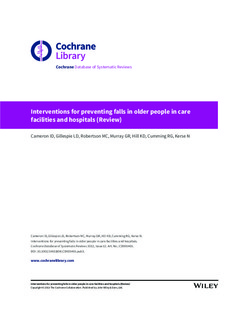| dc.identifier.citation | Cameron, I.D., Gillespie, L.D., Robertson, M.C., Murray, G.R., Hill, K.D., Cumming, R.G. & Kerse, N. (2012) Interventions for preventing falls in older people in nursing care facilities and hospitals. Cochrane Database of Systematic Reviews 2012, Issue 12. Art. No.: CD005465. | |
| dc.description.abstract | Background: falls in nursing care facilities and hospitals are common events that cause considerable morbidity and mortality for older people. Objectives: to assess the effectiveness of interventions designed to reduce falls by older people in nursing care facilities and hospitals. Search methods: we searched the Cochrane Bone, Joint and Muscle Trauma Group Specialised Register (January 2009); the Cochrane Central Register of Controlled Trials (The Cochrane Library 2008, Issue 2); MEDLINE, EMBASE, and CINAHL (all to November 2008); trial registers and reference lists of articles. Selection criteria: randomised controlled trials of interventions to reduce falls in older people in nursing care facilities or hospitals. Primary outcomes were rate of falls and risk of falling. Data collection and analysis: two review authors independently assessed trial quality an d extracted data. Data were pooled where appropriate. Main results: we included 41 trials (25,422 participants). In nursing care facilities, the results from seven trials testing supervised exercise interventions were inconsistent. This was the case too for multifactorial interventions, which overall did not significantly reduce the rate of falls (rate ratio (RaR) 0.82, 95% CI 0.62 to 1.08; 7 trials, 2997 participants) or risk of falling (risk ratio (RR) 0.93, 95% CI 0.86 to 1.01; 8 trials, 3271 participants). A post hoc subgroup analysis, however, indicated that where provided by a multidisciplinary team, multifactorial interventions reduced the rate of falls (RaR 0.60, 95% CI 0.51 to 0.72; 4 trials, 1651 participants) and risk of falling (RR 0.85, 95% CI 0.77 to 0.95; 5 trials, 1925 participants). Vitamin D supplementation reduced the rate of falls (RaR 0.72, 95% CI 0.55 to 0.95; 4 trials, 4512 participants ), but not risk of falling (RR 0.98, 95% CI 0.89 to 1.09; 5 trials, 5095 participants). In hospitals, multifactorial interventions reduced the rate of falls (RaR 0.69, 95% CI 0.49 to 0.96; 4 trials, 6478 participants) and risk of falling (RR 0.73, 95% CI 0.56 to 0.96; 3 trials, 4824 participants). Supervised exercise interventions showed a significant reduction in risk of falling (RR 0.44, 95% CI 0.20 to 0.97; 3 trials, 131 participants). Authors’ conclusions: there is evidence that multifactorial interventions reduce falls and risk of falling in hospitals and may do so in nursing care facilities. Vitamin D supplementation is effective in reducing the rate of falls in nursing care facilities. Exercise in subacute hospital settings appears effective but its effectiveness in nursing care facilities remains uncertain. | |
